Arkansas, with its diverse habitats ranging from dense forests to sprawling wetlands, is a haven for bird enthusiasts. Among its avian residents, the state boasts an array of stunning blue birds that captivate observers with their vivid hues.
Blue Birds Found In Arkansas
The diverse landscape of Arkansas, spanning from the lush Ozark Mountains to the expansive Mississippi Delta, provides a rich tapestry of habitats. This ecological variety, combined with the state’s strategic position along several migratory flyways, ensures that it hosts a remarkable array of bird species.
From the reclusive swamp birds in the bayous to the vibrant blue birds in the hardwood forests, the state’s geographical gifts offer a sanctuary for avian life.
Eastern Bluebird
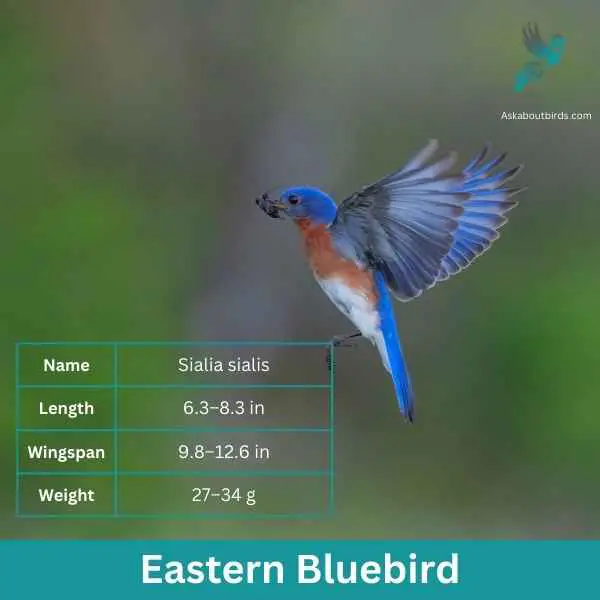
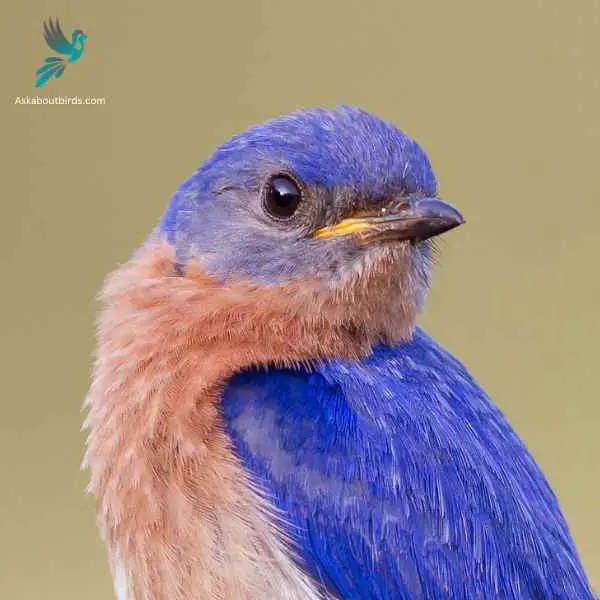
| Feature | Measurement |
|---|---|
| Scientific Name | Sialia sialis |
| Length | 6.3–8.3 in |
| Wingspan | 9.8–12.6 in |
| Weight | 27–34 g |
The Eastern Bluebird (Sialia sialis) is a small thrush found in open woodlands, farmlands, and orchards, and is recognized for its vibrant blue and red coloration. Male Eastern Bluebirds are dazzling with bright blue upperparts and a rusty or brick-red throat and breast, while females, though less colorful, still offer a similar pattern. The bird is native to North America and is commonly seen east of the Rockies, from Canada to the Gulf States and southeastern Arizona to Nicaragua.
Eastern Bluebirds feed on insects, wild fruit and berries. They have a gentle nature and are often seen perched alone or in small groups in the open, scanning the ground for prey. They are cavity nesters and will use old woodpecker holes or birdhouses if they are the right size.
Indigo Bunting


| Feature | Measurement |
|---|---|
| Scientific Name | Passerina cyanea |
| Length | 4.5–5.1 in |
| Wingspan | 7.1–9.1 in |
| Weight | 11.2–21.4 g |
The Indigo Bunting is a strikingly vibrant songbird, often hailed for its brilliant blue plumage and melodic song that graces woodlands and meadows during the warmer months.
Appearance: Males are renowned for their bright indigo blue feathers, which can appear darker in certain lights. Females and juveniles, on the other hand, are brown with subtle hints of blue on their wings and tail. The species lacks the vibrant streaking or spotting commonly found in many other songbirds.
Diet: Indigo Buntings primarily subsist on seeds, especially during non-breeding seasons. During the breeding season, they also consume a variety of insects such as beetles, caterpillars, and spiders, providing essential protein for their growing chicks.
Reproduction: Indigo Buntings build their nests close to the ground in shrubs or low tree branches. These nests, crafted meticulously with grasses and other plant materials, cradle clutches of typically 3 to 4 eggs. After hatching, the young are fed by both parents until they’re ready to fledge.
Blue Jay
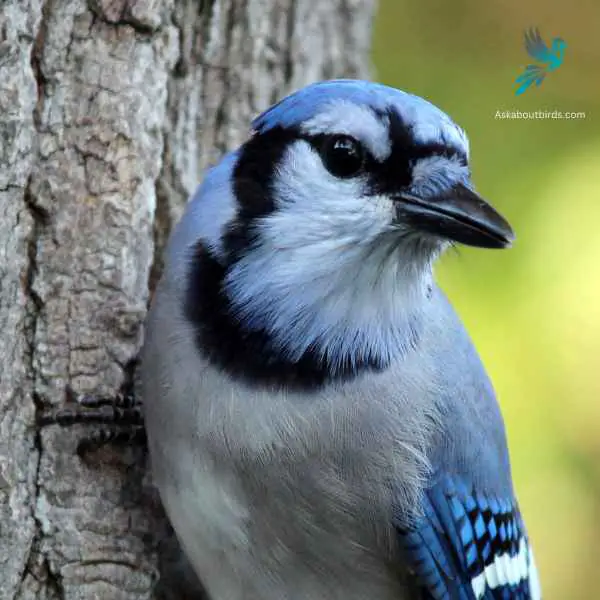
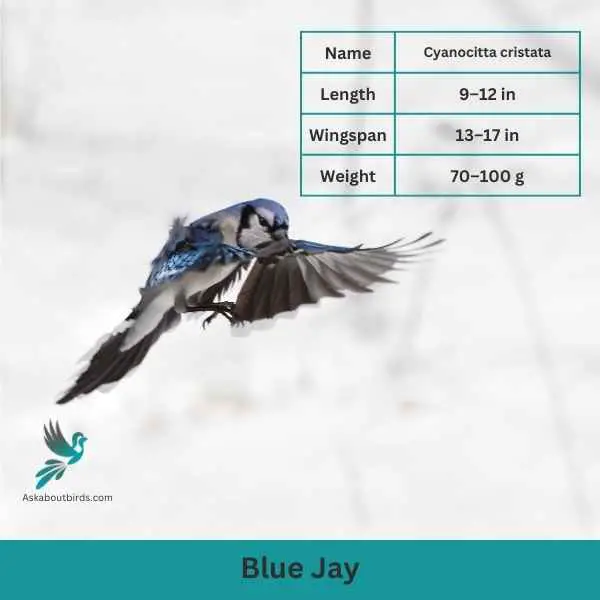
| Feature | Measurement |
|---|---|
| Scientific Name | Cyanocitta cristata |
| Length | 9–12 in |
| Wingspan | 13–17 in |
| Weight | 70–100 g |
The Blue Jay is a vibrant and easily recognized bird, known for its intelligence, distinctive calls, and bold behavior, commonly found throughout the eastern and central United States.
Appearance: The Blue Jay sports a striking blue upper body with white and black markings. Its face has a pronounced white patch with a black necklace that runs across the throat and around the head. The bird also features a pronounced blue crest, which can be raised or lowered, and its wings and tail are brightly colored with black bars and white tips.
Diet: Blue Jays are omnivores. Their diet consists primarily of seeds, nuts, especially acorns, fruits, and small insects. They’ve also been known to eat eggs or nestlings of other birds occasionally. Blue Jays often store food items in caches to eat later.
Reproduction: Blue Jays are monogamous birds that form long-lasting pair bonds. They typically build their nests in trees or large shrubs, constructing them from twigs, grass, and sometimes using mud as a binder. The female lays a clutch of 3 to 6 eggs, which are pale blue or sometimes white with brown speckles.
Blue Grosbeak
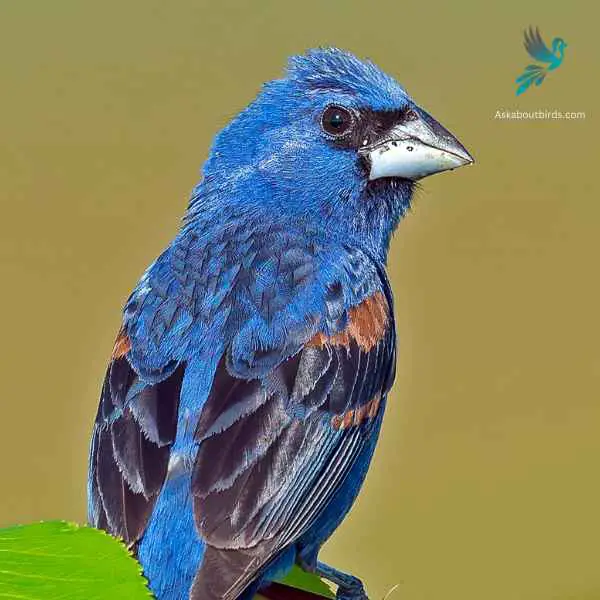
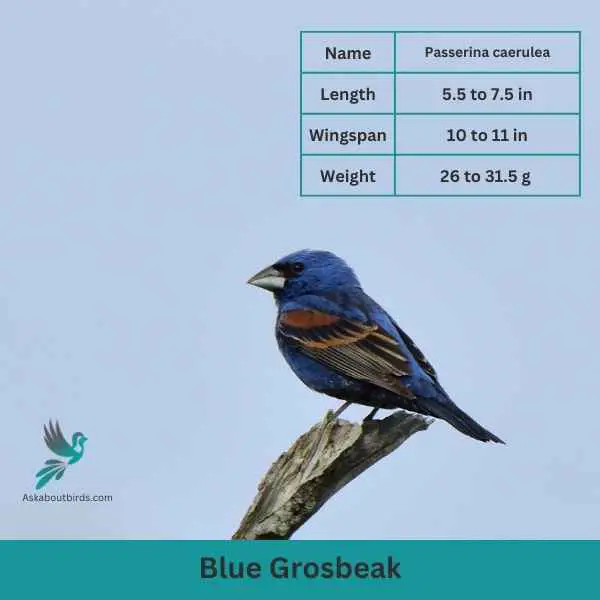
| Feature | Measurement |
|---|---|
| Scientific Name | Passerina caerulea |
| Length | 5.5 to 7.5 in |
| Wingspan | 10 to 11 in |
| Weight | 26 to 31.5 g |
The Blue Grosbeak is a medium-sized songbird found in North and Central America. The male Blue Grosbeak displays stunning plumage with deep blue feathers on its body and head, while the female has more subdued brownish tones. Both sexes have a thick, conical bill, which gives them their name “grosbeak,” meaning large beak.
These birds prefer open habitats such as grasslands, brushy areas, and woodland edges. Blue Grosbeaks are known for their melodious songs, which consist of a series of rich and varied notes. They primarily feed on seeds and insects, using their strong beaks to crack open seeds and forage on the ground or in low vegetation.
Blue-winged Warbler
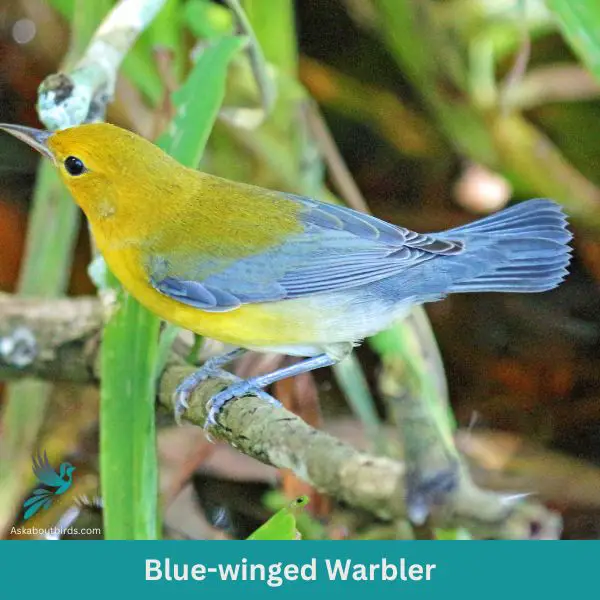
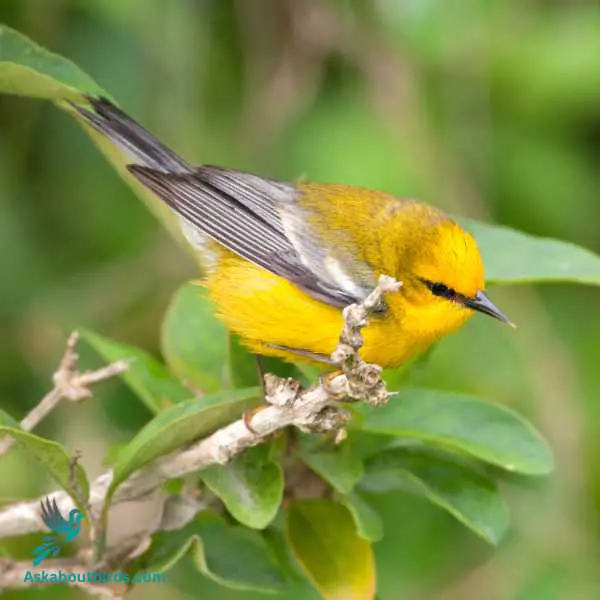
| Trait | Blue-winged Warbler |
|---|---|
| Scientific Name | Vermivora cyanoptera |
| Length | 4.3-4.7 inches |
| Wingspan | 6.7-7.5 inches |
| Weight | 0.3-0.4 ounces |
The Blue-winged Warbler is a vibrant songbird that stands out with its lemon-yellow coloring and buzzing song.
Appearance: This warbler displays a brilliant yellow body contrasted by blue-gray wings and a slim, black line through the eyes. The wings also feature two white wing bars.
Diet: The diet of the Blue-winged Warbler primarily consists of insects and spiders. They actively forage in shrubs and low trees, picking off their prey from the foliage.
Reproduction: Blue-winged Warblers build their nests on or near the ground, using grasses and other fine materials. The female lays a clutch of 4-6 eggs, which she incubates.
Blue-headed Vireo
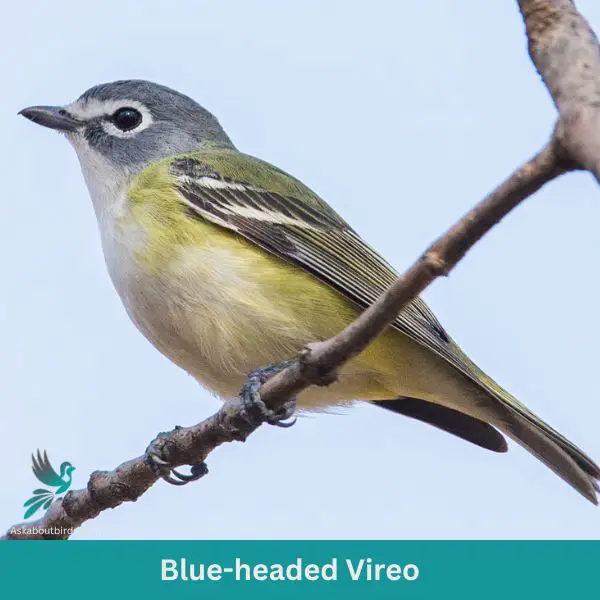
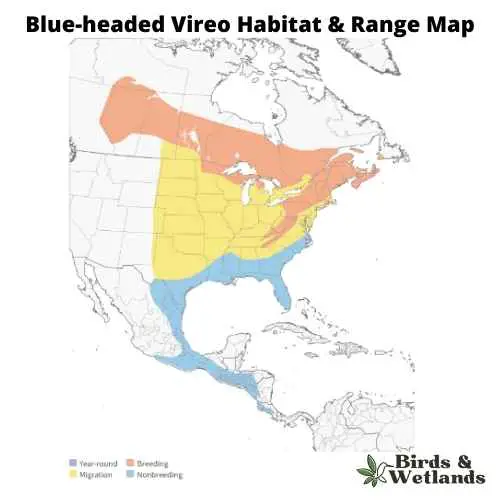
| Trait | Blue-headed Vireo |
|---|---|
| Scientific Name | Vireo solitarius |
| Length | 5-5.5 inches |
| Wingspan | 7.9-9.8 inches |
| Weight | 0.4-0.6 ounces |
The Blue-headed Vireo is a songbird recognized for its sharp and clear song as well as its distinct coloration.
Appearance: It has a blue-gray head and nape, contrasting sharply with its white throat and belly. A white eye ring combined with two white wing bars and yellowish flanks further accentuate its appearance.
Diet: The Blue-headed Vireo feeds mainly on insects and spiders. It often forages in the forest canopy, picking prey off leaves and twigs.
Reproduction: The female constructs a cup-shaped nest made of twigs, bark, and spiderwebs, often placed in the fork of a tree branch. Typically, she lays a clutch of 3-5 eggs. Both parents share the responsibility of incubating the eggs and feeding the chicks.
Cerulean Warbler
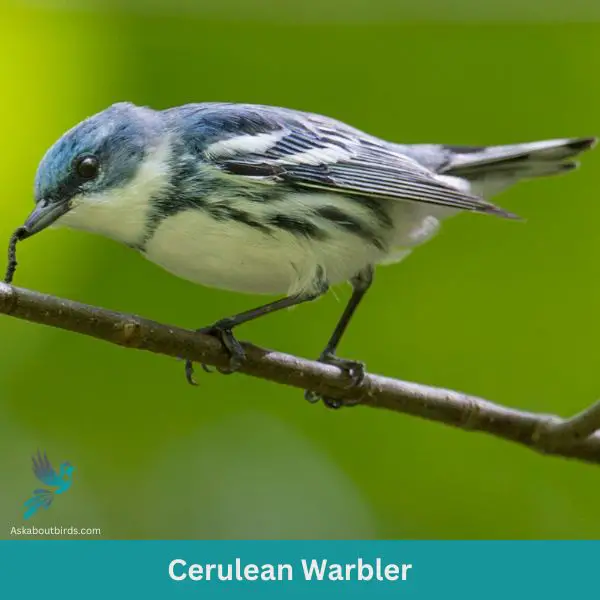
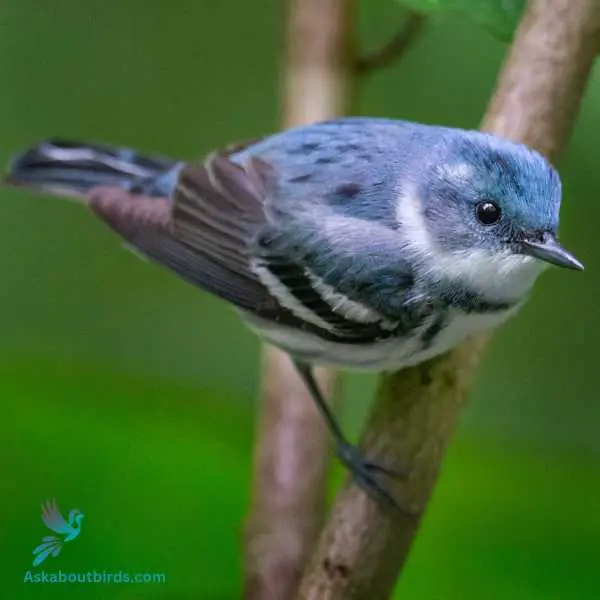
| Trait | Cerulean Warbler |
|---|---|
| Scientific Name | Setophaga cerulea |
| Length | 4.5 inches |
| Wingspan | 7.9-8.7 inches |
| Weight | 0.3-0.4 ounces |
The Cerulean Warbler is a striking songbird known for its sky-blue plumage and flitting movements in the forest canopy.
Appearance: Males boast a vibrant cerulean blue color on their upperparts, with streaked underparts, and a black necklace. Females have a more subdued bluish-green hue and lack the prominent black markings seen in males.
Diet: The diet of the Cerulean Warbler is predominantly made up of insects and spiders. They actively forage high in the treetops, gracefully maneuvering through leaves and branches.
Reproduction: Cerulean Warblers nest in the upper branches of tall deciduous trees. The female weaves a shallow cup-shaped nest and lays a clutch of 3-5 eggs.
Northern Parula
Scientific Name: Setophaga americana
Length: 4.3-4.7 inches
Wingspan: 6.3-7.1 inches
Weight: 0.2-0.4 oz
The Northern Parula is a small warbler recognized for its vibrant coloration and melodic song.
Appearance: The Northern Parula displays a bluish-gray plumage on its upperparts and a yellowish chest with a distinctive dark band. Males often have a brighter appearance, with striking blue feathers on the head and back.
Diet: Northern Parulas mainly feed on insects and spiders. They are adept foragers, often flitting through foliage to pluck their prey from leaves, branches, or even in mid-air.
Reproduction: Northern Parulas create pendant-shaped nests, often constructed from mosses and lichens. These nests are typically located high in trees. The female lays a clutch of 3-7 eggs, which are white with brown markings.
Belted Kingfisher

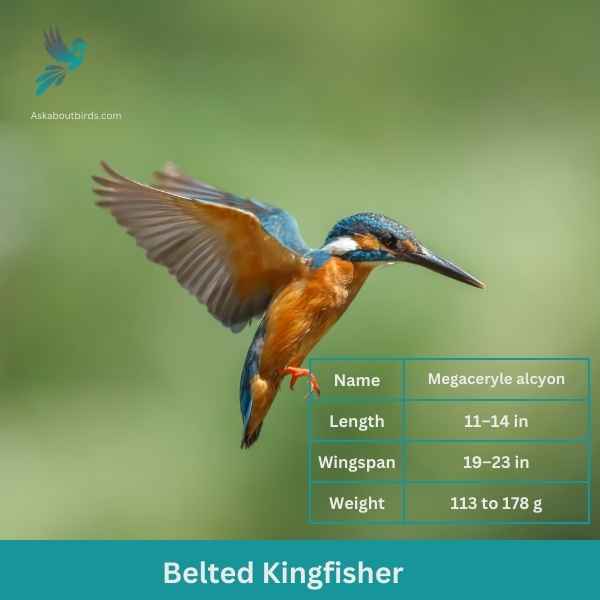
| Feature | Measurement |
|---|---|
| Scientific Name | Megaceryle alcyon |
| Length | 11–14 in |
| Wingspan | 19–23 in |
| Weight | 113 to 178 g |
The Belted Kingfisher is a distinctive and easily recognizable bird, frequently observed near water bodies, where it can be seen diving headfirst to catch prey.
Appearance: Sporting a prominent crest, the Belted Kingfisher has a slate blue-gray upper body and white underparts. Males possess a single blue band across their white chests, while females have an additional rufous band, making them one of the few bird species where females are more brightly colored than males. Their bill is long, sharp, and dagger-like.
Diet: As expert fishers, Belted Kingfishers mainly prey on small fish, but they’ll also consume crustaceans, insects, and amphibians. They’re known for their hunting tactic of hovering over water, spotting their prey, and then diving swiftly to snatch it.
Reproduction: Belted Kingfishers nest in burrows which they excavate in sandy or earthen banks, usually adjacent to water. The tunnel can be anywhere from 3 to 6 feet long, ending in a chamber. Within this chamber, the female lays a clutch of 5 to 8 white eggs.
Little Blue Heron
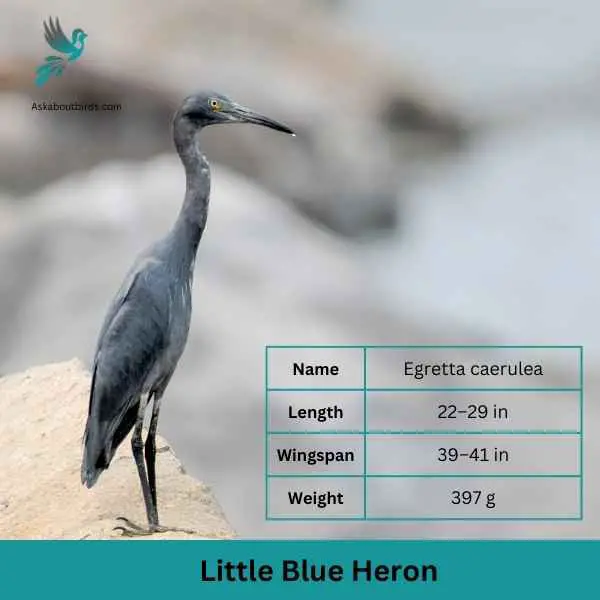
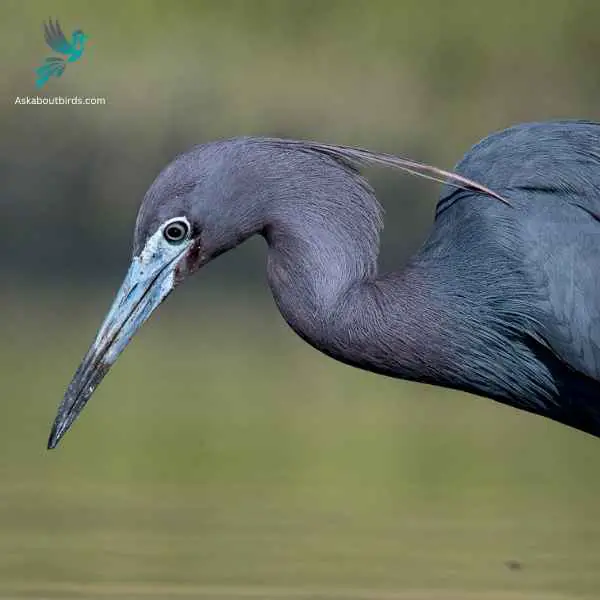
| Feature | Measurement |
|---|---|
| Scientific Name | Egretta caerulea |
| Length | 22–29 in |
| Wingspan | 39–41 in |
| Weight | 397 g |
The Little Blue Heron is a slender and elegant wading bird, often seen foraging in freshwater or saltwater habitats, especially in the southeastern parts of the United States.
Appearance: This heron undergoes a fascinating color transition as it matures. Juvenile Little Blue Herons are white, but they gradually acquire the slate-blue plumage that characterizes adults. The adult has a dark blue-gray body with a purplish neck and head. Their bill is grayish with a black tip.
Diet: The diet of the Little Blue Heron consists mainly of small fish, but they also feed on crustaceans, insects, and other small aquatic animals. Using stealth, they slowly stalk their prey in shallow waters before striking with their long, sharp bill.
Reproduction: Little Blue Herons nest in colonies, often with other wading birds. They build platform nests in trees or shrubs close to water bodies. The female typically lays a clutch of 3 to 5 pale blue eggs. Both parents participate in incubation and feeding the chicks once they hatch.
Blue-winged Teal

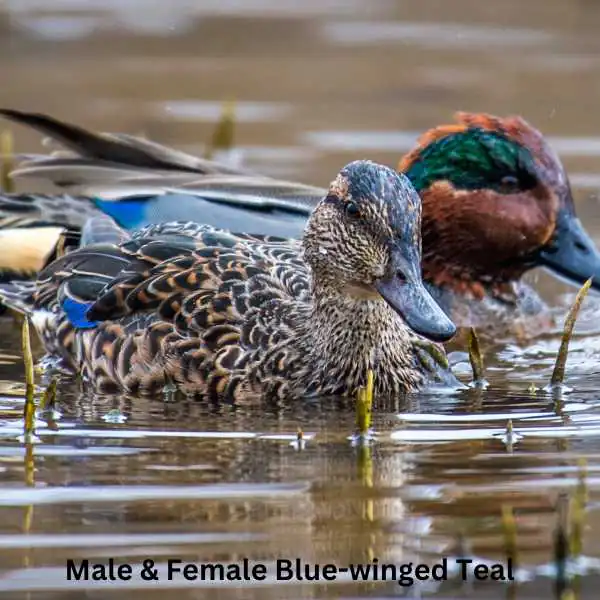
Listen to Blue-winged Teal
Scientific Name: Spatula discors
Length: 16 in
Wingspan: 23 in
Weight: 13 oz
The Blue-winged Teal is a small species of dabbling duck known for its striking plumage and its extensive migratory habits.
Appearance: Male Blue-winged Teals are quite colorful, with a slate gray head and neck, a white crescent in front of the eyes, and a predominantly brown body with specks of black. The name “Blue-winged” comes from the patch of blue feathers visible on their wings during flight. Females, in contrast, are primarily brown and subtly mottled to provide camouflage.
Diet: The Blue-winged Teal feeds mainly on plant matter, such as seeds and aquatic vegetation. However, they also supplement their diet with small invertebrates, especially during the breeding season. They are known for their “dabbling” behavior, where they feed at the surface of the water rather than diving.
Reproduction: Blue-winged Teals prefer to nest on the ground in grassy areas near water. The female typically lays a clutch of 9 to 13 eggs, which she incubates alone for about three weeks. After hatching, the ducklings can feed themselves but remain under the mother’s protection until they are capable of flying.
Blue-gray Gnatcatcher
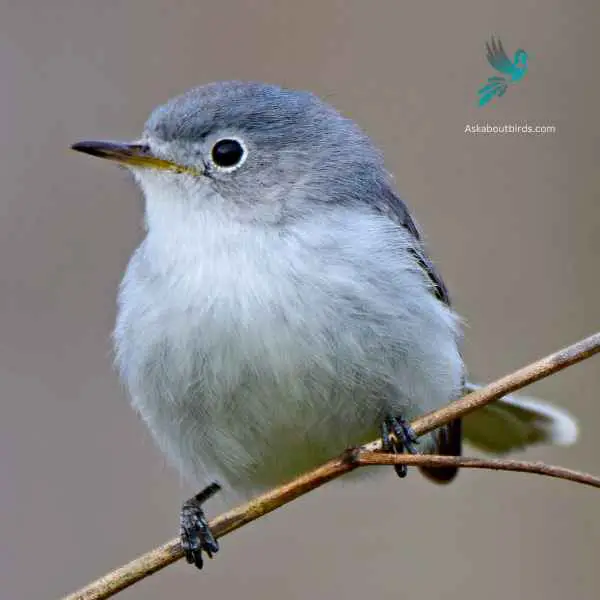
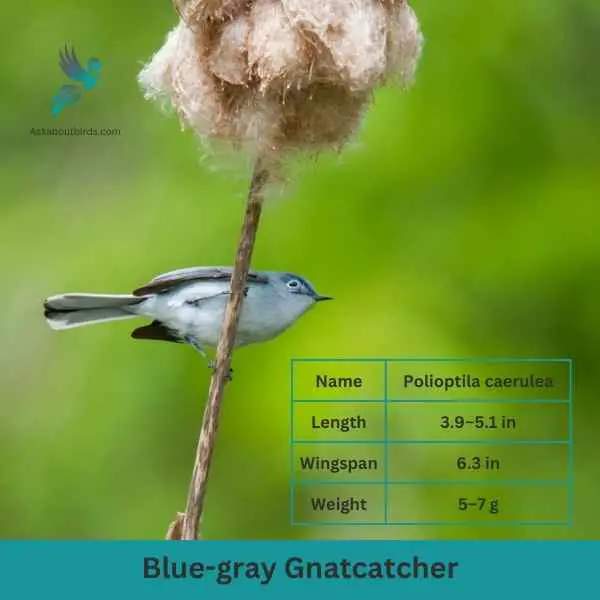
| Feature | Measurement |
|---|---|
| Scientific Name | Polioptila caerulea |
| Length | 3.9–5.1 in |
| Wingspan | 6.3 in |
| Weight | 5–7 g |
The Blue-gray Gnatcatcher is a petite, active bird, frequently observed flitting about treetops, emitting its distinctive high-pitched calls as it moves agilely through the branches.
Appearance: This bird exhibits a predominantly blue-gray plumage with a subtle white eye ring and long, slender tail feathers. The tail has distinctive black and white edging, with the males sometimes showing a faint black line on their forehead during the breeding season.
Diet: Blue-gray Gnatcatchers primarily feed on small insects and spiders. They’re adept hunters, foraging actively among foliage and even catching insects in mid-air.
Reproduction: These birds weave compact, cup-shaped nests on tree branches using plant materials, spider webs, and lichen. The exterior of the nest often matches the tree bark, making it well camouflaged. Inside, the female lays a clutch of 3 to 5 blue or greenish eggs, which she incubates.
Where to Spot Arkansas’ Blue Birds
Arkansas, with its lush landscapes and varied topography, is a haven for bird enthusiasts, offering some of the most vibrant bird-watching spots in the nation. Here are the top locations that stand out for their rich avian diversity:
- Holla Bend National Wildlife Refuge: Located near Dardanelle, this refuge spans over 7,000 acres of forests, wetlands, and grasslands. It’s especially renowned for its wintering waterfowl, providing a stage for spectacular migrations.
- Lake Chicot State Park: Situated in southeastern Arkansas, Lake Chicot is the state’s largest natural lake. Its surrounding cypress-filled wetlands and delta habitats attract a wide array of water birds and blue bird species.
- Buffalo National River: This pristine, free-flowing river winds through the heart of the Ozarks. The region’s cliffs, caves, and forests serve as the perfect backdrop to spot an array of blue birds and raptors.
- Mount Magazine State Park: As the highest point in Arkansas, Mount Magazine offers unique montane habitats. Here, birders can find species that are otherwise rare in the state, including several blue bird variants.
- Big Lake National Wildlife Refuge: Nestled in northeastern Arkansas, this refuge is a mix of swamps, lakes, and hardwood forests. A magnet for migratory species, it’s an ideal location for observing diverse blue birds and other vibrant avian species.
| State’s Blue birds | Top Spots for Blue Birds |
|---|---|
| Missouri’s Blue birds | 1. Mingo National Wildlife Refuge 2. Busch Conservation Area 3. Mark Twain National Forest |
| Tennessee’s Blue birds | 1. Great Smoky Mountains National Park 2. Reelfoot Lake State Park 3. Radnor Lake State Park |
| Mississippi’s Blue birds | 1. Noxubee National Wildlife Refuge 2. Sardis Lake 3. DeSoto National Forest |
| Louisiana’s Blue birds | 1. Kisatchie National Forest 2. Sabine National Wildlife Refuge 3. Atchafalaya National Wildlife Refuge |
| Texas’s Blue birds | 1. Big Bend National Park 2. Guadalupe Mountains National Park 3. Brazos Bend State Park |
| Oklahoma’s Blue birds | 1. Wichita Mountains Wildlife Refuge 2. Beaver’s Bend State Park 3. Tallgrass Prairie Preserve |
FAQs on Blue Bird Species Found in Arkansas
What does the indigo bunting range map indicate about their habitat?
The indigo bunting range map showcases the regions where these blue beauties predominantly reside. They are mainly found in North America during the breeding season and migrate to Central and South America for the winter. Their colorful plumage, especially among male species, makes them a sight to behold. Offering bird feeders stocked with sunflower seeds in your backyard can attract these small birds, transforming any space into a birdwatcher’s paradise.
How do barn swallow range maps help in understanding their migratory patterns?
Barn swallow range maps provide insights into the migratory routes and habitats of these birds. Predominantly, barn swallows can be found across North America and, during winter, they head to Central and South America. Their long bill and white belly make them distinctive. As social birds, they often move in large flocks. If you’re keen on attracting such backyard birds, providing them with nest boxes can be beneficial.
Why are bluebird boxes essential for purple martins?
Purple martins, known for their vibrant colors and social nature, rely heavily on nest boxes, especially in urban areas like Hot Springs Village and golf courses in places like New Mexico. Bluebird boxes are commonly referred to as suitable nest sites for these birds, although they’re larger than typical small bird boxes. As they primarily eat insects, these boxes, when placed in backyards, can help control insect populations.
How can bird feeders help in observing American robins during winter?
American robins, with their distinct colorful plumage, are a common sight in North American backyards. While they don’t typically rely on bird feeders as much as other species, during winter months when food sources become scarce, they might frequent feeders stocked with small seeds and whole peanuts. Having a bird feeder in your backyard can, therefore, increase the chances of spotting these beautiful birds even during the colder months.
